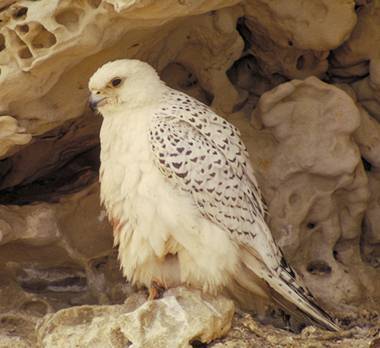Gyrfalcon
Iceland Falcon, Greenland Falcon, Gerfalcon, Jer-falcon Scientific Name: Falco rusticolus
Fri, 1st November, 2024 - 10:40 am GMT
Sponsor Ads:

Alternative Name
Iceland Falcon, Greenland Falcon, Gerfalcon, Jer-falcon Scientific Name: Falco rusticolusBasic Info
Gyrfalcons reach about 22 inches in length at maturity. Their wingspan may reach over 60 inches and these birds can weigh more than four and a half pounds. Gyrfalcons have different colorations depending on their home ranges. In more northern areas, these birds are almost entirely white. In more southern areas, they begin to have darker feathering. Some have gray plumage and others are black. The Gyrfalcon has the typical falcon's pointed wings, dark eyes and notched beak.
Health
Like many larger species of raptor, the Gyrfalcon can be patient and more trusting than other birds with its handlers. They may also be more difficult to handle because of their sheer size and can be self-destructive. Breeding Gyrfalcons have their first breeding at two to three years of age and mate for life. These birds nest on the edges of cliffs that offer a bit of shelter from the weather. They will lay four to five eggs between April and May, and the majority of incubation is performed by the female. After about 36 days the eggs will hatch. By 30 days of age, young Gyrfalcons can feed themselves and will have fledged by 50 days of age. At 80 days, the young Gyrfalcons are fully independent. Mating pairs do not breed every year; rather, will generally have three breeding years out of five year periods. Usually between two and three young will survive.Habitat
N/ABehavior
Used in falconry for centuries, the Gyrfalcon is one of the larger falcons kept in captivity. These lovely birds are found in the wild in colder climates where they may be seen in graceful flights or skillful hunts. Often Gyrfalcons choose to make their homes near water or colonies of sea birds. They will prey on these birds in addition to their mainstay, Ptarmigans. Ducks or even geese have been known to fall to Gyrfalcons. When birds are scarce, Gyrfalcons may occasionally take mammals such as ground squirrels or lemmings. Gyrfalcons rely on large open spaces in which to hunt and each year their populations fluctuate according to Ptarmigan numbers. Although Gyrfalcons usually inhabit sub arctic and even arctic ranges, they will migrate to regions that are more southerly for the winter. Some of their southern migration ranges are the same northern ranges other birds abandon yearly to move even further south! The call of the Gyrfalcon is similar to that of the Peregrine Falcon, but is harsher and louder. These birds are valued in falconry for their size, enabling them to hunt larger prey than many birds. Usually they will bring down prey in flight, but Gyrfalcons have also been known to hunt prey on the ground.Origin
Native to North America, Greenland, Europe and AsiaHistory
Found in arctic and sub-arctic areas throughout the northern hemisphere, Gyrfalcons are native to North America, Greenland, Europe and Asia. They prefer wooded habitats near water or mountainous regions. Unlike many birds, Gyrfalcons have not been excessively harmed by human destructive tendencies. They generally live in such northerly regions that there is little or no chemical residue in their prey and they face little threat from habitat loss. Although the Gyrfalcon has been traditionally used in falconry since the European Middle Ages, their numbers have not suffered terribly from the capture of wild birds.Common Foods
sea birdsSponsor Ads:
Today's conservative is yesterday's liberal who got mugged last night. -- Unknown
Gyrfalcon
Coded by: BGID® | ALL RIGHTS RESERVED Copyright © 2000-2024
Disclaimer | Privacy | Report Errors / Contact | Credits

 President of the United States of America - Real Estate mogul, Pageant owner and now one of the most controversial men in political history.
President of the United States of America - Real Estate mogul, Pageant owner and now one of the most controversial men in political history.  Politician, US Vice President and President of the USA - Joseph Robinette Biden Jr.
Politician, US Vice President and President of the USA - Joseph Robinette Biden Jr.  versus
versus  Russia: 'The Evil Empire'? Are they all that bad or is it just the USA trying to portray Russia as bad because they are a world power with land bigger and a society very different from the USA ideal?
Russia: 'The Evil Empire'? Are they all that bad or is it just the USA trying to portray Russia as bad because they are a world power with land bigger and a society very different from the USA ideal?  Global warming has been in and out as the "latest" hot topic for many years. It is, according to modern scientists, the result of man-made industrial pollutants, clearing forested areas, agriculture, etc. But now they are thinking it started way before the Industrial Revolution...
Global warming has been in and out as the "latest" hot topic for many years. It is, according to modern scientists, the result of man-made industrial pollutants, clearing forested areas, agriculture, etc. But now they are thinking it started way before the Industrial Revolution... 
 Corona virus
Corona virus 
 Users with wide screen monitors can benefit from more content on every page.
Users with wide screen monitors can benefit from more content on every page.